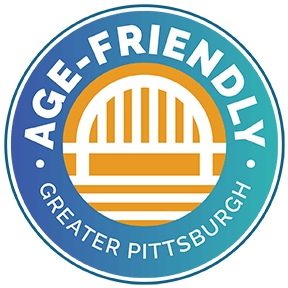How This Big City Is Becoming Age-Friendly
An insider's tale of making Pittsburgh great for residents of all ages
Imagine moving to the best neighborhood in your town. You live across from a park with walking paths, tennis courts and a farmer’s market. Down the street, there are all Italian, Indian and Vietnamese restaurants. From your window, there’s a breathtaking view of the skyline.

Now imagine living there, but only being able to access the view. Everything else — the places, the people and the buzz that make your neighborhood special and vibrant — is out of reach.
What a Pittsburgh Neighborhood Didn't Offer
It happened to my friend Rose, a retired landscape designer.

In 2006, Rose’s sciatic nerve was crushed during hip replacement surgery and she became disabled. Four years later, when she was 66 and unable to manage her single-family home in Pittsburgh, Rose moved to an accessible apartment north of town. Rent was high and she missed the city, so she applied to move to an affordable high-rise for people ages 62+ in Pittsburgh’s trendy Lawrenceville neighborhood.
At first, Rose felt like she’d won the lottery scoring a unit there. But it didn’t take long to realize that even though the building accommodates her power wheelchair, the neighborhood does not. Steep hills, step entrances and severed sidewalks are just a few of the obstacles she encounters outside her door.
That’s unfair to Rose, certainly. But it’s also unfair to everyone who’s missing out on Rose as a neighbor, as a friend and — to local businesses — as a consumer.
“I don’t have a lot of money to spend, but I’d buy a $5 latte three times a week,” she told me, pointing to a coffee shop. “That is, if I could get my wheelchair through the door.”
Making Pittsburgh Age-Friendly
At Age-Friendly Greater Pittsburgh, which I’ve helped spearhead since January 2016, we’re working hard to make Rose’s neighborhood and the entire region an easier, more enjoyable place to live for everyone — especially older generations. Our project is part of the age-friendly movement, a World Health Organization (WHO) and AARP network that includes 541 communities internationally and 210 in the United States.
In Pennsylvania, as is the case across the country, our age demographics underscore the urgency. More than 55 percent of households here have someone 60 or older living in them, according to the Pennsylvania Department of Aging. And from 2016 to 2020, the 60+ set is expected to increase by a stunning 25 percent.
Still, it’s hard to break through the noise, especially in a city that’s counting on Millennials to fuel its transformation from steel town to innovation hub. Google, Uber and Facebook are just a few tech giants to open up shop here recently. (Amazon just named Pittsburgh a finalist for its second headquarters location.)
It’s my job to be sure policymakers and other leaders understand our demographic realities as a strength and consider people of all ages and incomes — not just affluent newcomers — when they think about the future. We know that nearly 90 percent of older Americans want to age in place. However,”place” is more than a house or a skyline view. It’s a community, and all the opportunities it provides. It’s a sense of belonging.
Making a city age-friendly can be challenging, but also incredibly rewarding. Here’s how we’ve been doing it in Pittsburgh:
Redesigning Cities For All Ages
In October 2017, Pittsburgh and Allegheny County (both part of the World Health Organization and AARP Network of Age-Friendly Communities) launched the Age-Friendly Greater Pittsburgh Action Plan, a 30-step roadmap developed by neighbors and for neighbors to elevate inclusion across generations over the next three years.
The launch builds on years of progress by community partners and was the culmination of two years of planning made possible through support from the Mary Hillman Jennings Foundation. The voices of more than 100 organizations and 800 residents of all ages are represented in the plan.
Although we used WHO’s eight domains of livability framework to guide us, we’ve grouped our 30 action items into three focus areas:
Access We will improve entry points, participation and navigation to new options and opportunities — within neighborhoods and health systems — for people of all ages and abilities.
For example: Complete Streets is championing policies and practices to reduce accidents involving pedestrians — such as audible pedestrian signals with countdown timers. Also in the works: a housing asset map showing affordable, accessible and inclusive options to help consumers make informed choices and build a case for increased future options.
Connection We will strengthen intergenerational relationships to combat social isolation and loneliness, creating spaces that encourage coming together and celebrating initiatives that put relationships first.
Two examples: 1) Expanding senior center activity to visible, public settings like parks and schools, as well as opening senior centers to nontraditional users and groups after hours and 2) Collaboration with arts organizations to offer new ways for generations to engage, such as matching younger and older neighbors to participate in the arts together and foster intergenerational dialogue.
Innovation We will champion meaningful technology and ideas that enable people to age in community and help neighbors of all ages collaborate with our region’s growing tech industry.
Two examples: 1) Offering online, interactive classes through the Virtual Senior Academy, developed locally by the Jewish Healthcare Foundation to connect older residents and build digital literacy and 2) Intergenerational, in-person technology training that taps into Pittsburgh’s growing tech community for volunteers, many of whom may be younger and new to the region.
One action item already taking shape: The Crossings, which are pop-up street performances that build visibility and spark change for safer crosswalks. So far, Age-Friendly Greater Pittsburgh has staged three, high-energy performances complete with jumbo signs, fancy hats and James Brown tunes. Inspired by work from 2016 Influencer in Aging Anne Basting, the playful, attention-grabbing events are captured on video and followed by data collection and local advocacy. A recent performance in Pittsburgh’s Little Italy drew more than 90 neighbors and included one hula-hooping dinosaur.
With 130 municipalities in our county and 90 distinct neighborhoods in our city, we have our work cut out for us. But Age-Friendly Greater Pittsburgh’s focus will remain on reaching neighbors — and making sure the community is always within reach.

